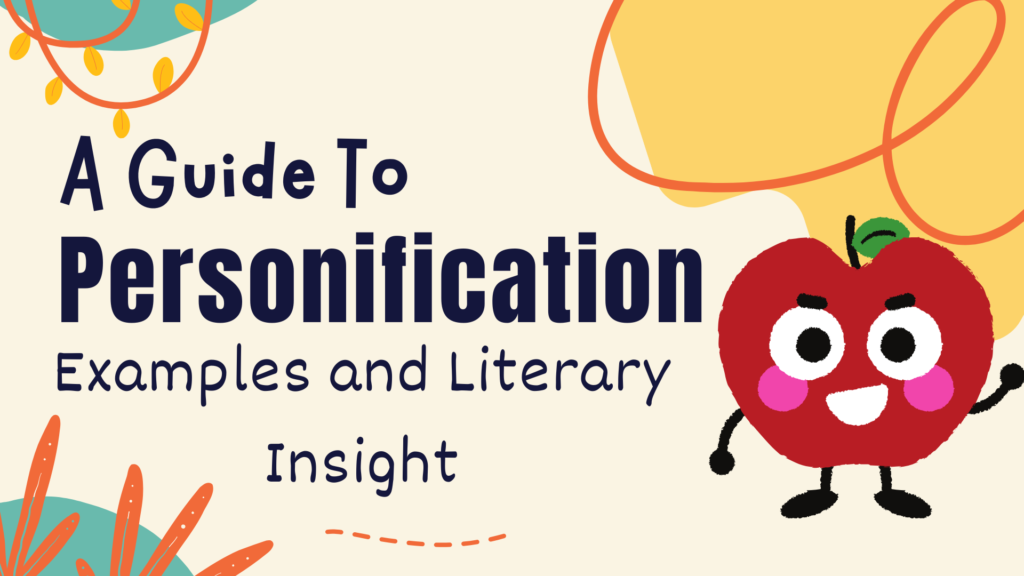Here, we proudly bring an outstanding article on the Guide to Personification with examples.

Have you ever read a sentence where the sky seemed to whisper secrets or the wind seemed to dance with joy? That’s not just poetic flair — that’s personification in action. This timeless literary device doesn’t just decorate your writing; it transforms it.
In this guide, we’ll explore what personification is, why writers love using it, and how you can recognize it in everything from novels and songs to daily conversations.
What Is Personification?
At its core, personification is a type of figurative language that gives human qualities to nonhuman things. These “things” could be animals, objects, or even abstract concepts like time or love.
By attributing actions, emotions, or intentions to inanimate subjects, personification breathes life into language and engages the reader’s imagination in profound ways.
Simple Yet Striking Examples of Personification
Personification is all around us, especially in storytelling and speech. Let’s explore a few clear examples:
- The morning sun peeked shyly through the curtains.
- The sun doesn’t have eyes or feelings, but this paints a peaceful, cozy picture of dawn.
- The city never sleeps.
- Cities don’t actually sleep — people do. But this phrase captures the endless buzz of urban life.
- The wind howled angrily through the night.
- The wind can’t feel anger, but this sets a tense and stormy mood.
- Time marches on.
- Time isn’t a soldier, yet this metaphor captures its unstoppable, rhythmic passage.
Each of these lines makes the sentence more vivid and emotionally charged.
Hope you are enjoying the Guide to Personification with Examples.
Why Writers Use Personification
Personification isn’t just poetic — it’s powerful. Authors use it to:
- Evoke emotion: Saying “the storm growled” creates tension more effectively than “a loud storm occurred.”
- Deepen atmosphere: Describing fog as “creeping” adds mystery and motion to a static scene.
- Reflect character emotion: A character feeling nervous might notice that “the walls seemed to close in.”
Here’s a compelling transformation:
- Literal: “The sun rose.”
- Personified: “The sun stretched its golden arms over the mountains and smiled at the world.”
- This second version evokes warmth, beauty, and a sense of beginning — all without adding extra length.
Personification in Literature: A Closer Look
Writers have used personification for centuries. Here are some notable literary examples:
From A Separate Peace by John Knowles
“Peace had deserted Devon… the village retained much of their dreaming summer calm… all had been caught up, like the first fallen leaves, by a new and energetic wind.”
In this passage, peace deserts, the village dreams, and the wind becomes an energetic force, creating mood and metaphor all at once.
From Hamlet by William Shakespeare
“The slings and arrows of outrageous fortune…”
Here, “fortune” is portrayed as actively launching attacks — it becomes a character in Hamlet’s internal battle with destiny.
Personification in Modern Music
Yes, even your favorite songs are filled with personification! Here are a few safe, family-friendly examples:
- “Because the night belongs to lovers” – Patti Smith / Bruce Springsteen
- The night is personified as belonging to someone, giving it human ownership and emotional depth.
- “The sun is shining, the weather is sweet” – Bob Marley
- Weather isn’t “sweet” in the literal sense, but this description evokes a joyful, musical tone.
- “Lightning strikes every time she moves” – Calvin Harris ft. Rihanna
- Lightning is presented as reacting to a person’s movement — giving it agency and flair.
These examples demonstrate how songwriters utilize personification to infuse their lyrics with mood and metaphor, thereby making their words resonate emotionally with listeners.
This article, “Guide to personification with examples,” will surely help the learners develop their writing skills.
Personification vs. Anthropomorphism
It’s easy to confuse personification with anthropomorphism — they’re related but not quite the same.
- Personification gives human traits to things briefly or symbolically.
- Example: “The wind whispered.”
- Anthropomorphism treats nonhuman entities as if they were fully human, often attributing to them speech, thoughts, and personalities.
- Example: A talking rabbit who wears a coat and attends tea parties.
Cartoon animals in movies like Zootopia or Kung Fu Panda are anthropomorphic — they behave in entirely human-like ways.
Final Thoughts: Why Personification Still Matters
Personification is more than a literary flourish — it’s a bridge between the human experience and the world around us. It helps us understand abstract ideas, relate to nature, and feel deeper emotions when reading, writing, or even just listening to music.
So next time the leaves “whisper” or your phone “dies,” remember — it’s personification making your world feel a little more alive.
Outro: Let Your Words Come Alive
Whether you’re writing fiction, analyzing poetry, or crafting compelling content, personification is your creative companion. It’s the difference between writing that sits still and writing that dances off the page.
Try this:
Describe a rainy day without saying “rain” or “wet.” Use personification to set the mood — and see how much more powerful your words become.
I hope you enjoyed this article on ‘Guide to Personification with Examples.’